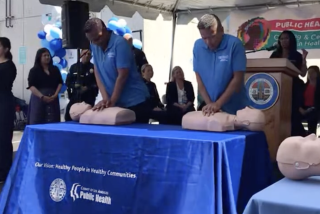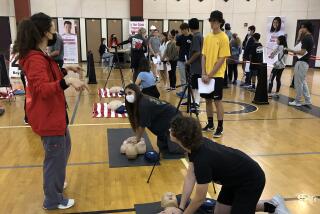U.S. OKs 1st Implanted Electronic Hand
- Share via
WASHINGTON — The Food and Drug Administration on Monday approved a new, surgically implanted electronic hand that will enable some quadriplegics to grasp, hold and release objects.
The Freehand system operates through a substitute for the nerve impulses from the brain that normally tell a hand when and how to move. In their place, patients have two-inch devices surgically placed in the chest; electrodes extending from there go under the skin to the hand muscles. When a patient jerks a shoulder, an electronic signal is sent telling the hand what to do.
“This is a godsend, tremendous breakthrough,” said Geoffrey Thrope, national sales manager for NeuroControl Corp., the Cleveland-based company that developed the system. “You are talking about people who are now depending on someone to feed them, hold their glass, pick up a book. . . . It’s a new world of independence.”
The Freehand system is designed for those paralyzed by a spinal cord injury who still have some use of their shoulders, upper arms and elbows but cannot move their wrists and hands. Until now, they have been forced to rely on the assistance of others, or external devices that let them type on computers by blowing into a mouthpiece or feed themselves with a fork strapped to a hand.
*
With the new device, such individuals would be able to write letters, feed themselves, answer the telephone and perform a number of other tasks. The FDA estimates that 54,000 Americans may benefit from the system. The company predicts that the total cost, including the necessary surgery, will be about $50,000.
The system achieves control over the hand through the implantation of a battery and a microprocessor into the chest. That device is then connected to electrodes threaded by wire under the skin, down the arm to the hand muscles. Through the following process, the system makes it possible for a paralyzed hand to move:
Patients wear a small joystick on the opposite arm that responds to movements of the shoulder and sends an electronic signal. The signal travels through a cord into a computer box on the individual’s wheelchair that translates the information into radio waves. A cord from the computer box directs the radio waves to a transmission coil in the chest that sends the message to the implant, which in turn makes the hand move.
When the patient moves the shoulder that has the joystick back or down, depending on what feels most comfortable, the hand of the opposite arm closes. And when the patient moves the shoulder forward or up, the hand opens. A quick jerk of the shoulder will lock the hand, enabling the patient to hold onto objects like a fork or a pen. Because the patients getting the implant already can move their arms, they can turn their hand up and down.
*
“It’s a significant technological advance,” said Dr. Bruce Burlington, the FDA’s medical device chief. “A lot of people will benefit. People will be able to have more control.”
Burlington cautions, however, that the selection of patients for the Freehand implant requires “a very careful prescreening.” Quadriplegics who have a pacemaker, suffer from infection or uncontrolled spasms will not be able to use it. And those that do get it will have to be trained to use it.
Many of the 61 quadriplegics who tested the system reported it had improved their lives.
The device “has given me a sense of confidence and a sense of freedom both mentally and physically,” said Tammy Wilson, 30, who was paralyzed in a 1986 car accident and received the implant in June 1996. “It’s nice to do things independently instead of having someone doing it for you.”
It took Wilson three weeks to get used to the device, and she can now brush her hair and teeth and put on makeup without any trouble. It has given her a tremendous boost, she said, to be able to raise her glass at birthday parties and toast with the other people at the table.
*
The device is not fail-safe, however. Twenty percent of the tested patients required additional surgery to reposition the device, repair damage to the skin, replace broken electrodes or remove electrodes because of infection. Side effects also included swelling, discomfort and skin irritation.
(BEGIN TEXT OF INFOBOX / INFOGRAPHIC)
Hand Implant
The Freehand system enables some people with quadriplegia to grasp, hold and release objects.
1. Shoulder position sensor: Translates the shoulder’s back-and-forth movements and quick jerks into signals.
2. External controller: A computer box, usually located on the wheelchair, receives the signal and translates it into radio waves before sending it on to the transmission coil.
3. Transmitter coil is worn over the implanted stimulator
4. Implanted stimulator is a pacemaker-size device that sends electrical stimulation to eight electrodes
5. Electrodes, the stimulation causes muscles to contract, providing a functional hand grasp.






